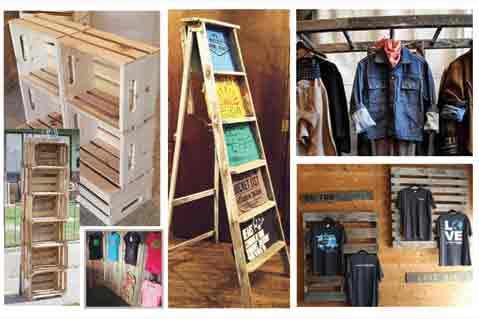February 13, 2017
How to Display Your Products
Your Artwork Dilemma:
One decision every shop will face is how to show off what it produces. Will a permanent display be part of the shop layout? Does it need to be portable for shops that work at craft shows and other events? What’s the budget for creating a display? How will customers be interacting with it? An ideal display will meet a shop’s needs, while also acting as a dynamic selling tool that best presents items in an appealing, inspiring and informative way.

Solve this dilemma:
The first thing to do is to sit down and answer the above questions. It may be that some shops will want one permanent display for use in the shop proper and another to take on the road. Other shops that operate in a space that isn’t open to customers, or sell exclusively at events will only need a traveling display. Another consideration is what the display is intended to do. Will it include blank shirts to give examples of types and sizes available? Will it encompass multiple decoration techniques? Finally, consider the budget. For smaller budgets, a look book with pictures or a home-built display may be best. For shops with larger budgets, custom-built displays may suit.
Takeaway Tips
1. If you’re designing a display that will be taken to events, remember that lightness and portability are key. Also consider ease of setup. The display must be durable, as it’ll frequently be taken down and put up. A fragile display won’t stand the stress of constant moving. A display that’s too heavy or complicated will cause stress of a different sort for shop employees. The ideal combination is something lightweight and strong that can be set up easily.
2. Another thing to consider with a portable display is how much room it takes to transport. Most shops that travel to events use a car, van or small box truck. A display that takes up too much space will be costlier to transport and harder to set up. Collapsible displays require less space and are generally easier to set up.
3. Displays range in cost from $20 for simple cardboard setups to hundreds of thousands of dollars for custom wood and metal devices. A good display will pay for its own cost by helping sell additional product.
4. Make sure your static display is durable enough for your needs. Ask yourself: Is this display intended to be part of my shop fixtures, or will things be changed or removed frequently? Will customers be able to take parts of the display down to feel materials or prints?
5. A display is a form of advertising and should echo your shop’s branding. So, if you sell primarily heavy metal band T-shirts, don’t set up a display decorated with pastel colors, for example.
Watch This!
Packing and display are cornerstones of marketing and, if done right, increase sales. This Transfer Express video shares 25 ideas for creating attention-grabbing displays.